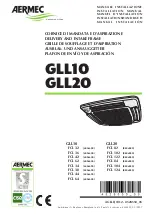
Manual 2100-034G
Page
19 of 21
Unit Modes of Operation
terminates, the reversing valve will shift back to heating mode and the outdoor fan will restart. There is typically a large
puff of steam emitted as the fan restarts. When the heat pump shifts from cool to heating mode, from heating to cooling
mode and especially during defrost cycles, there will be a pressure transfer sound heard as the reversing valve redirects
the flow of refrigerant. This is commonly described as a hissing noise and is a normal sound for this type equipment.
For air source heat pumps, it is important to keep heavy snow from accumulating around the machine to the point
of blocking the inlet and outlet openings to the outdoor coil section. For wall mounted or other equipment that is
elevated, this should not be a factor; but for equipment installed on or near the ground, this can be an issue in
areas prone to heavy and/or blowing snow. The air source heat pump cannot operate effectively and efficiently when
snowbound just as a car cannot function well in heavy snow conditions.
Water-to-Air Cooling and Heating Products (Geothermal Heat Pumps)
These types of heat pumps are also commonly referred to as water source or geothermal systems. Just like the air
source heat pump, they are refrigerant-based systems that both heat and cool using a compressor for both modes of
operation. The primary difference is that the system uses water or antifreeze-protected water solution instead of an
air-cooled outdoor heat transfer coil, and there is no outdoor motor/fan system but instead a water pump to provide
adequate water flow to the system.
Cooling Mode
The cooling mode of a water-to-air heat pump is exactly the same as that described for an air conditioner in the
previous Air Conditioner section, except that the outdoor coil uses water instead of air for the heat transfer medium.
Heat Mode
The system operates in reverse cycle, meaning that it acquires and moves heat from the water supply flowing through
the water to refrigerant coil and transfers it indoors to be rejected into the circulating air stream.
Most water-to-air heat pumps (but not all) will also be equipped with some amount of electric heat to supplement
the heating capacity of the compressor system on an as-needed basis. This operation is entirely automatic and is
controlled by the indoor thermostat.
Because of the design of water-to-air heat pumps and the water temperatures involved, no defrost system is required
as in air-to-air heat pumps.
Water Supply Systems
Depending upon the type and application of the water-to-air heat pump, the water side of the system could be one of
the following:
1. Individual closed loop buried in a trench or vertical bore hole(s).
2. Individual loop submerged in a pond.
3. Water supplied from a well and discharged into pond, stream, ditch or another well.
4. Water supplied from a boiler/tower system, typically only in larger multi-unit installations.
Summary of Contents for Q-TEC Q A4D Series
Page 2: ......
Page 24: ......
Page 65: ...Manual 2100 752C Page 41 of 41 GRAPH 3 Q48A4D FAD Ventilation Delivery ...
Page 66: ......
Page 81: ...Manual 2110 1568G Page 15 of 17 This page intentionally left blank ...
Page 84: ......
Page 95: ......
















































